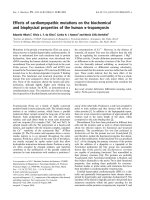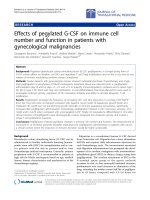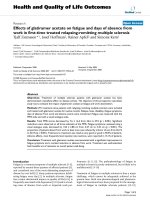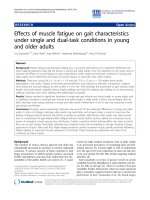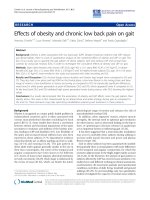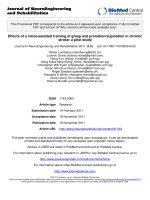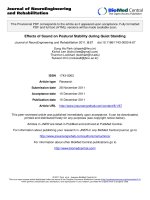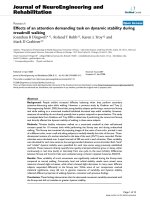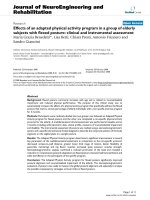báo cáo hóa học:" Effects of rock wool on the lungs evaluated by magnetometry and biopersistence test" docx
Bạn đang xem bản rút gọn của tài liệu. Xem và tải ngay bản đầy đủ của tài liệu tại đây (280.95 KB, 7 trang )
BioMed Central
Page 1 of 7
(page number not for citation purposes)
Journal of Occupational Medicine
and Toxicology
Open Access
Research
Effects of rock wool on the lungs evaluated by magnetometry and
biopersistence test
Yuichiro Kudo*
1
, Makoto Kotani
1
, Masayuki Tomita
2
and Yoshiharu Aizawa
1
Address:
1
Department of Preventive Medicine and Public Health, Kitasato University School of Medicine, 1-15-1, Kitasato, Sagamihara, Kanagawa
228-8555, Japan and
2
NICHIAS Corporation, 1-26, Shibadaimon 1-chome, Minato-ku, Tokyo 105-8555, Japan
Email: Yuichiro Kudo* - ; Makoto Kotani - ; Masayuki Tomita - tomita-
; Yoshiharu Aizawa -
* Corresponding author
Abstract
Background: Asbestos has been reported to cause pulmonary fibrosis, and its use has been
banned all over the world. The related industries are facing an urgent need to develop a safer
fibrous substance. Rock wool (RW), a kind of asbestos substitute, is widely used in the construction
industry. In order to evaluate the safety of RW, we performed a nose-only inhalation exposure
study in rats. After one-month observation period, the potential of RW fibers to cause pulmonary
toxicity was evaluated based on lung magnetometry findings, pulmonary biopersistence, and
pneumopathology.
Methods: Using the nose-only inhalation exposure system, 6 male Fischer 344 rats (6 to 10 weeks
old) were exposed to RW fibers at a target fiber concentration of 100 fibers/cm
3
(length [L] > 20
μm) for 6 hours daily, for 5 consecutive days. As a magnetometric indicator, 3 mg of triiron
tetraoxide suspended in 0.2 mL of physiological saline was intratracheally administered after RW
exposure to these rats and 6 unexposed rats (controls). During one second magnetization in 50
mT external magnetic field, all magnetic particles were aligned, and immediately afterwards the
strength of their remanent magnetic field in the rat lungs was measured in both groups.
Magnetization and measurement of the decay (relaxation) of this remanent magnetic field was
performed over 40 minutes on 1, 3, 14, and 28 days after RW exposure, and reflected cytoskeleton
dependent intracellular transport within macrophages in the lung. Similarly, 24 and 12 male Fisher
344-rats were used for biopersistence test and pathologic evaluation, respectively.
Results: In the lung magnetometric evaluation, biopersistence test and pathological evaluation, the
arithmetic mean value of the total fiber concentration was 650.2, 344.7 and 390.7 fibers/cm
3
,
respectively, and 156.6, 93.1 and 95.0 fibers/cm
3
for fibers with L > 20 μm, respectively. The lung
magnetometric evaluation revealed that impaired relaxation indicating cytoskeletal toxicity did not
occur in the RW exposure group. In addition, clearance of the magnetic tracer particles was not
significantly affected by the RW exposure. No effects on lung pathology were noted after RW
exposure.
Conclusion: These findings indicate that RW exposure is unlikely to cause pulmonary toxicity
within four weeks period. Lung magnetometry studies involving long-term exposure and
observation will be necessary to ensure the safety of RW.
Published: 27 March 2009
Journal of Occupational Medicine and Toxicology 2009, 4:5 doi:10.1186/1745-6673-4-5
Received: 30 October 2008
Accepted: 27 March 2009
This article is available from: />© 2009 Kudo et al; licensee BioMed Central Ltd.
This is an Open Access article distributed under the terms of the Creative Commons Attribution License ( />),
which permits unrestricted use, distribution, and reproduction in any medium, provided the original work is properly cited.
Journal of Occupational Medicine and Toxicology 2009, 4:5 />Page 2 of 7
(page number not for citation purposes)
Background
Rock wool (RW) is a kind of asbestos substitute and is
widely used in the construction industry, in particular for
fire-resisting insulation, thermal insulation, and acoustic
absorption. However, some asbestos substitutes, includ-
ing RW fibers, resemble asbestos morphologically, and
their possible harmful effects on humans have been a con-
cern. Pulmonary fibrosis has occurred in rats experimen-
tally exposed to RW, but no development of lung tumors
was noted [1]. Regarding the safety of RW, the Interna-
tional Agency for Research on Cancer (IARC) at present
classifies RW as Group 3: limited evidence in experimen-
tal animals for the carcinogenicity, and inadequate evi-
dence in humans for the carcinogenicity [2,3].
Lung magnetometry was first performed by Cohen in
1973 [4]. The primary feature of this method is that this is
an in vivo test of the living organism, and the proper func-
tion of the main defense cell in the lung (macrophages)
can be non-invasively monitored. Using this method, we
can obtain knowledge about the intracellular movement
of alveolar macrophages, after making them to ingest
magnetic particles, by measuring the remanent magnetic
field strength in the lung after external magnetization.
Since the ingested magnetic particles remain in the phago-
somes, intracellular movement of the phagosomes can be
detected by measurement of remnant magnetic field [5-7].
To date, we have evaluated the cytotoxicity of chrysotile, a
type of asbestos, as well as RW and other man-made vitre-
ous fibers (MMVFs), by cell magnetometry that was origi-
nally devised in our laboratory [8-12]. This method
determines cytoskeleton-dependent functions of macro-
phages, which play an important role in phagocytosis, to
evaluate the degree of injury caused on macrophages. In
our previous report, the cell magnetometric evaluation
revealed that RW is less cytotoxic than chrysotiles [11].
Biological effects of MMVFs need to be evaluated not only
at the cell level but also in the lung. To our knowledge,
however, there have been no studies to evaluate the safety
of RW by means of lung magnetometry. We thus per-
formed the present study with the aim of evaluating the
potential of RW to cause pulmonary injury. In this study,
rats were forced to inhale RW by a nose-only inhalation
exposure system, then evaluated by lung magnetometry,
biopersistence test (changes over time in the number and
size of fibers that retained in the lungs) and pathological
examination.
Methods
The present study was performed in accordance with the
Ethical Guidelines for Animal Experimentation adopted
by the Institutional Review Board of Kitasato University
School of Medicine (Approval No. 2004022).
Materials
As an experimental material, we used an RW sample man-
ufactured by NC Co., Ltd., Japan that was provided by the
Rock Wool Association, Japan. Fluorescence X-ray spec-
troscopy showed that the RW used in the present study
was chemically composed of SiO
2
39%, CaO 33%, Al
2
O
3
14%, MgO 5.0%, Fe
2
O
3
1.8%, and S 0.6%.
Originally, RW is present in the form of lumps of different
fiber sizes (both length and width). We adjusted the RW
fiber size in accordance with the method of Kohyama et
al. (1997) to obtain fiber samples of appropriate size for
animal experiments [13]. RW fibers thus obtained were
dispersed in an exposure chamber and the fiber sizes were
measured. Their geometric mean length (geometric stand-
ard deviation, GSD) and geometric mean width (GSD)
were 15.49 (2.02) μm and 2.44 (1.59) μm, respectively.
Then, to make it easier to generate RW in the nose-only
inhalation exposure system, the pressurized and pulver-
ized RW fibers were mixed with glass beads (BZ-02, AS
ONE Corporation, Osaka, Japan) at a weight ratio of 1
(RW) to 39 (glass beads).
Exposure study
Male Fischer 344 (F344) rats (6 to 10 weeks old; which is
specifically recommended by EC Protocol, 1999) were
used for each experiment. To acclimatize the rats to the
environment of the laboratory, they were first housed in
cages for about one week with free access to water and
food. The temperature was kept at 22°C and 40% humid-
ity, with a continuous supply of fresh filtered air.
In the lung magnetometric evaluation, an exposure group
and a control group comprised 6 rats each. The study
material (RW fibers) was supplied with air into the expo-
sure chamber and exposed to the noses of rats of the expo-
sure group in the same way as reported previously [14-
16]. The rats in the control group were not exposed to RW
but underwent lung magnetometry only.
In the biopersistence test, 12 rats were used per experi-
ment and the experimental was repeated twice, and in
phathological evaluation, 12 rats were used (36 rats in
total). The rats were exposed to RW fibers continuously
for 6 hours daily for 5 consecutive days. Each day during
the experimental period, the rats fixed in the upper rat
holders of the main chamber were replaced by the rats in
the lower rat holders, rotating the positions among the
upper and lower rat holders.
Lung magnetometry
Figure 1 shows an outlined view of the lung magnetomet-
ric evaluation apparatus. Magnetometric evaluation of
lungs was performed in 6 rats each of RW-exposed and
control groups according to the method reported by
Journal of Occupational Medicine and Toxicology 2009, 4:5 />Page 3 of 7
(page number not for citation purposes)
Aizawa et al. (1991). One day after exposure, rats were
anesthetized by inhalation of diethyl ether. In this study
triiron tetraoxide (Toda Kogyo Corp., Tokyo, Japan) was
used as magnetic particles with the geometric mean parti-
cle size of 0.26 μm.
RW-exposed and control rats were intratracheally cathe-
terized and instillated with 3 mg of triiron tetraoxide sus-
pended in 0.2 mL of physiological saline one day after RW
exposure. Each rat was then anesthetized with intraperito-
neal Nembutal (at 0.15 mL/100 g body weight). Magnet-
ization for one second was performed to the rat chest
under a magnetic flux density of 50 mT, followed by a 40-
minute measurement of strength of the postmagnetiza-
tion remanent magnetic field with a fluxmeter of flux-gate
type. The apparatus was operated in such a way that the
sample table passed over the probe once every 12 seconds.
Magnetization and measurement of the remanent mag-
netic field of the lung was performed 1, 3, 14, and 28 days
after RW exposure. By measuring the remanent magnetic
field over 40 minutes postmagnetization, a curve indicat-
ing the decay constant can be obtained. Further, measure-
ment of the remnant magnetic field strength for 2 min
postmagnetization gave a nearly linear curve when plot-
ted after logarithmic transformation. The point at which
this curve intersected with the y-axis was designated B
0
.
When expressing the remnant magnetic field immediately
after magnetization as B
0
and the decay constant as λ, the
remnant magnetic field after t seconds of termination of
external magnetization can be represented by the formula
B = B
0
e
-λt
, and thus the decay constant (λ) was calculated
based on this formula. In addition, the maximum
strength of remanent magnetic field on each measure-
ment day (t = 0 - minute value) was calculated with the
value on Day 0 taken as 100%, on the basis of which clear-
ance curves were prepared.
Biopersistence test
One, 3, 14 and 28 days after exposure, 6 rats were sacri-
ficed a time (1D group, 3D group, 14D group, and 28D
group, respectively). Rats were weighed once every week.
During and after exposure, rats were intermittently moni-
tored for any change in their appearance or condition.
Under Nembutal anesthesia, rats were sacrificed by exsan-
guination from the abdominal aorta and their lungs were
resected. The resected lungs were ashed in a low-tempera-
ture asher (Plasma Asher, LTA-102, Yanaco Corp., Kyoto,
Japan) over 24 hours.
The ashed specimen containing fibers was suspended in
distilled water that had been filtered with a Minisart (Sar-
totius K. K., Tokyo, Japan) syringe filter unit in a weighing
bottle. Fibers were collected on a Nuclepore filter (pore
diameter, 0.2 μm) using a suction filter, and allowed to
dry. At least 400 fibers were counted for each rat by use of
a scanning electron microscope (BX41, Olympus Corp.,
Tokyo, Japan) at ×500 to ×2000 magnification. Fibers
counted were those having an aspect ratio (ratio of length
to width) of 3 or greater. The number of fibers in each of
the three categories of length (L) (L ≤ 5, 5 < L ≤ 20, or L >
20) was obtained in accordance with the rules for fiber
counting [17]. Among the fibers counted, World Health
Organization (WHO) fibers – which have a length of
longer than 5 μm and a width of shorter than 3 μm [2] –
were also counted. The fiber number was then converted
to the fiber number per weight of dried lung. The half-life
of fibers in the rat lungs was calculated assuming that the
geometric mean of the total fiber number/the total lung
weight (fibers/mg) in the lungs of the 1D group was 100%
[3].
Furthermore, the fiber size (length and width) was meas-
ured at ×500 to ×2000 magnification. In this measure-
ment, fibers having a length of 0.47 μm or greater and a
width of 0.05 μm or greater were included.
Pathological evaluation
Three rats each were sacrificed 1, 3, 14, and 28 days after
RW exposure. Their lungs were isolated and fixed in for-
malin, followed by observation of lung tissue by hema-
toxylin and eosin staining using a transmission electron
microscope.
Statistical analysis
In the lung magnetometric evaluation, arithmetic mean
values and standard deviations were calculated from data
obtained for the RW-exposed and control groups of 6 rats
each. Subsequently, Students' t-test was conducted.
Lung magnetometric evaluation apparatusFigure 1
Lung magnetometric evaluation apparatus.
Journal of Occupational Medicine and Toxicology 2009, 4:5 />Page 4 of 7
(page number not for citation purposes)
In the biopersistence test, geometric mean and geometric
standard deviation were calculated for the total fiber
number, length and width. For length and width, at least
400 fibers in lungs per rat were counted in two experi-
ments and the geometric mean value for 6 rats was calcu-
lated. One-way analysis of variance was performed and
Scheffe's multiple comparison test was conducted.
Results
Fiber concentration and weight concentration in exposure
chamber
In the lung magnetometric evaluation, the arithmetic
mean (standard deviation, SD) of the total fiber concen-
tration in the exposure chamber during the experiment
was 650.2 (367.3) fibers/cm
3
, and 156.6 (104.7) fibers/
cm
3
for fibers with L > 20 μm. The arithmetic mean (SD)
of the weight concentration was 170.4 (29.3) mg/m
3
.
In the biopersistence test, the arithmetic mean (SD) of the
fiber concentration was 344.7 (161.6) fibers/cm
3
for all
fibers and 93.1 (50.2) fibers/cm
3
for fibers with L > 20 μm.
The arithmetic mean (SD) of the weight concentration
was 100.0 (29.9) mg/m
3
.
In the pathological evaluation, the arithmetic mean (SD)
of the fiber concentration was 390.7 (170.4) fibers/cm
3
for all fibers and 95.0 (45.8) fibers/cm
3
for fibers with L >
20 μm. The arithmetic mean (SD) of the weight concen-
tration was 100.2 (26.4) mg/m
3
.
Lung magnetometry
Assuming that the percentage of remanent magnetic field
strength immediately after magnetization on each meas-
urement day was 100%, the percentages of 40-minute
postmagnetization period were calculated and plotted to
construct relaxation curves. In both the RW-exposed and
control groups, relaxation was rapid on all measurement
days, as shown in Figure 2. No significant differences in
decay were noted between the two groups on any of the
study days. Between day 1 and day 14 there was an
increase in the decay constant indicating an acceleration
of relaxation during this time period. The decay constant
during a 2-minute postmagnetization period did not sig-
nificantly differ between the two groups on any measure-
ment day (Figure 3).
The percentage of the remanent magnetic field strength
immediately after magnetization (B
0
) on each measure-
Relaxation of triiron tetraoxide microparticles in the lungFigure 2
Relaxation of triiron tetraoxide microparticles in the lung. In both the RW-exposed and control groups, relaxation
was rapid on all measurement days.
0
20
40
60
80
100
0 5 10 15 20 25 30 35 40
Time after magnetization (minutes)
Magnetic field strength
Control
RW
(%)
Mean ± S.E. (n = 6)
Journal of Occupational Medicine and Toxicology 2009, 4:5 />Page 5 of 7
(page number not for citation purposes)
ment day was calculated with the value obtained one day
after exposure taken as 100%. The decay of B
0
shows the
retention and clearance of the magnetic particles in the
lung. Both the RW-exposed and control groups showed
rapid magnetic particle clearance. In the RW-exposed
group, however, magnetic particle clearance was impaired
in tendency (Figure 4).
Biopersistence test
Table 1 shows the changes over time in the number of RW
fibers that retained in lungs, and Figure 5 shows the per-
centage of the number of the retained fibers, calculated
with the geometric mean of the 1D group taken as 100%.
The total fiber number, fiber number by size, and WHO
fiber number decreased over time in the observation
period. The results of Scheffe's multiple comparisons
showed that the fiber number in all categories signifi-
cantly decreased in the 28D group as compared with the
1D group (p < 0.05) (Table 1).
The half-lives of RW fibers were calculated from an expo-
nential approximation curve after the geometric mean of
the 1D group was taken as 100%. The half-lives were 35
days for all fibers, 16 days for the fibers with L > 20 μm,
and 35 days for WHO fibers. These findings indicate that
the half-life of RW fibers with L > 20 μm was shorter (16
days) than that of all fibers or WHO fibers (35 days),
showing that RW fibers have lower biopersistence.
As shown in Table 2, both length and width reduced over
time in the observation period. Upon Scheffe's multiple
comparisons, the 3D and 28D groups showed signifi-
cantly shorter widths than the 1D group (p < 0.05) (Table
2).
Pathological evaluation
An electron microscope image of the lung in the 28D
group showed that macrophages retained morphologi-
cally almost normal nuclei and cytoplasm. Lung tissues
did not show pulmonary fibrosis and were almost normal
(data not shown).
Discussion
The principle of lung magnetometry is to apply external
magnetization to lungs in which magnetic particles are
retained. After withdrawal of the external magnetization,
a weak remanent magnetic field of the lung can be
detected. Rapid decay of the remanent magnetic field fol-
lowing withdrawal of magnetization is called relaxation.
Triiron tetraoxide phagocytosed by alveolar macrophages
Changes over time in decay constant after infiltration of trii-ron tetraoxide particlesFigure 3
Changes over time in decay constant after infiltra-
tion of triiron tetraoxide particles. The decay constant
during a 2-minute postmagnetization period did not signifi-
cantly differ between the two groups on any measurement
day.
0
1
2
3
4
1 3 14 28 (days)
(×10
-3
/s)
Control
RW
Mean ± S.E.
䋨
n = 6
䋩
Days after RW exposure
Decay constant d
Clearance of iron particles from rat lungs determined by lung magnetometryFigure 4
Clearance of iron particles from rat lungs deter-
mined by lung magnetometry. Both the RW-exposed
and control groups showed rapid magnetic particle clear-
ance.
0
20
40
60
80
100
1101928
(days)
(%)
Control
RW
Mean ± S.E.
䋨
n = 6
䋩
Days after RW exposure
Magnetic particle retention
Changes in the intrapulmonary fiber count over timeFigure 5
Changes in the intrapulmonary fiber count over
time. The percentage of the number of fibers retained in the
lungs in each group calculated with the geometric mean of
the 1D group taken as 100%.
0
20
40
60
80
100
All fibers L
㻟
5 5 < L
㻟
20 20 < L WHO fiber
(%)
1D group 3D group 14D group 28D group
RW fiber retention
Journal of Occupational Medicine and Toxicology 2009, 4:5 />Page 6 of 7
(page number not for citation purposes)
is magnetized by external magnetization and arranged so
as to be orderly aligned in a single direction, and after
withdrawal of external magnetization, the phagosomes
rotate cytoskeleton-dependently at random, resulting in
rapid decay of the remanent magnetic field. When a toxic
substance capable of causing pulmonary injury is admin-
istered, however, the substance may have physical and/or
chemical effects on the cytoskeleton, impairing phago-
some motion and retarded decay of the magnetic lung
field. This slower rotation means that it is less likely for
magnetic particles to deviate from the alignment, which
may result in delayed relaxation.
Relaxation is only noted in living bodies and not observed
in autopsied lungs or lungs isolated from dead animals.
Accordingly, lung magnetometry enables noninvasive
evaluation of pulmonary toxicity in living subjects. In
addition, measurement of remanent magnetic field
strength from immediately after external magnetization to
a subsequent follow-up period allows estimation of time-
course changes (clearance) in the quantity of persistent
magnetic particles in lungs. When a lung-toxic substance
is simultaneously administered, the clearance of magnetic
particles is delayed, which enables the determination of
whether or not the substance is responsible for lung
injury. The decay constant indicates the degree of cytotox-
icity: the greater this value, the smaller the cytotoxicity.
Aizawa et al. performed studies using lung magnetometry,
in which gallium arsenide or silica was intratracheally
administered in rabbits, indicating that relaxation and
clearance were delayed in a dose-dependent manner
[18,19].
The relaxation curves obtained in the present study did
not significantly differ between the RW-exposed and con-
trol groups, showing rapid relaxation in both groups. It is
considered that after RW exposure, phagosomes could be
efficiently transported along the cytoskelton, resulting in
rapid relaxation.
The decay constant was determined for two minutes fol-
lowing withdrawal of magnetization, during which the
remanent magnetic field usually rapidly reduces. The
greater the value, the more rapid is the relaxation.
Between the RW-exposed and control groups, no signifi-
cant difference was observed in decay constant, which
may indicate that phagosomes rapidly rotated even after
RW exposure, as shown by the relaxation curves. The
decay constant increased with time, reflecting faster relax-
ation and uptake of magnetic particles by macrophages.
There may be another possibility of decrease in magnetic
particle size (smaller particles show faster relaxation).
The clearance curves revealed that the remanent magnetic
field strength – indicating the quantity of magnetic parti-
cles retained in lungs – determined immediately after
magnetization in the RW-exposed group reduced over
time as well as in the control group, showing no signifi-
cant differences between the two groups. These findings
Table 1: Geometric mean of number of fibers retained in the lung (geometric standard deviation)
Observation period All fibers L ≤ 55 < L ≤ 20 20 < L WHO fibers
10E5 fibers/g dry lung weight
1D group 93.3 (1.2) 45.6 (1.2) 41.4 (1.2) 6.2 (1.3) 47.6 (1.2)
3D group 85.6 (1.2) 41.5 (1.2) 38.8 (1.3) 4.1 (1.7) 43.0 (1.4)
14D group 65.5 (1.1)
a
32.2 (1.2)
a
29.8 (1.2) 2.7 (1.7)
a
32.7 (1.3)
28D group 55.6 (1.2)
a, b
26.4 (1.3)
a, b
26.9 (1.1)
a, b
2.0 (1.3)
a
29.0 (1.1)
a, b
a
: Comparison with the 1D group (p < 0.05)
b
: Comparison with the 3D group (p < 0.05)
L = Fiber length (μm)
WHO fibers: Fibers having a length of longer than 5 μm and width of shorter than 3 μm.
Table 2: Changes in length and width of fibers over time
Observation period Length Width
Geometric mean (Geometric standard deviation) (μm)
1D group 5.52 (2.48) 0.50 (1.86)
3D group 5.28 (2.38)* 0.48 (1.90)*
14D group 5.29 (2.30) 0.48 (1.91)
28D group 5.29 (2.22)* 0.48 (1.97)*
*: Comparison with the 1D group (p < 0.05)
Publish with BioMed Central and every
scientist can read your work free of charge
"BioMed Central will be the most significant development for
disseminating the results of biomedical research in our lifetime."
Sir Paul Nurse, Cancer Research UK
Your research papers will be:
available free of charge to the entire biomedical community
peer reviewed and published immediately upon acceptance
cited in PubMed and archived on PubMed Central
yours — you keep the copyright
Submit your manuscript here:
/>BioMedcentral
Journal of Occupational Medicine and Toxicology 2009, 4:5 />Page 7 of 7
(page number not for citation purposes)
may indicate that exposure to RW did not influence the
defense and clearance mechanisms in the lung.
In the biopersistence test, the number and sizes (length
and width) of fibers persisting in lungs decreased from
one day to 28 days after exposure. The reduction in the
number of persisting fibers may be related to excretion of
fibers by mucociliary movement or phagocytosis of fibers
by alveolar macrophages, and the reduced sizes (length
and width) of fibers retained in the lungs may be due to
dissolution in body fluid or mechanical destruction of fib-
ers [3]. The reason why longer fibers clear faster compared
to shorter fibers is considered to be that longer fibers may
primarily deposit in the airways and follow mucociliary
clearance while shorter fibers penetrate deeper into the
lung periphery. Pathological evaluation revealed no obvi-
ous changes.
Conclusion
The findings of the present study suggest that RW expo-
sure may not cause significant lung toxicity within four
weeks period. To further ensure the safety of RW, lung tox-
icity should be evaluated for at least one year after RW
exposure, in which we are engaged in our ongoing study.
Competing interests
The authors declare that they have no competing interests.
Authors' contributions
YK and MT have made substantial contributions to con-
ception and design, acquisition of data, and analysis and
interpretation of the data. MK has been involved in draft-
ing the manuscript and revising it critically for important
intellectual content. YA have given final approval of the
version to be published. All authors read and approved
the final manuscript.
Acknowledgements
We express our cordial gratitude to Ms. Yumiko Sugiura, Ms. Michiyo
Koyama, Ms. Etsuko Ohta, Mr. Kenji Mimura, and Ms. Sachiyo Hiyoshi,
Department of Preventive Medicine and Public Health, Kitasato University
School of Medicine, as well as to Ms. Noriko Nemoto, Electron Microscopy
Center for their precise and enthusiastic advice. This work was partly sup-
ported by a Grant-in-Aid for Scientific Research from the Ministry of Edu-
cation, Culture, Sports, Science and Technology, Japan in 2005.
References
1. McConnell EE, Axten C, Hesterberg TW, Chevalier J, Miller WC,
Everitt J, Oberdörster G, Chase GR, Thevenaz P, Kotin P: Studies
on the inhalation toxicology of two fiberglasses and amosite
asbestos in the Syrian golden hamster. Part II. Results of
chronic exposure. Inhal Toxicol 1999, 11:785-835.
2. IARC Working Group on the Evaluation of Carcinogenic Risks to
Humans: Man-made vitreous fibers. IARC Monogr Eval Carcinog
Risks Hum 2002, 81:1-3813.
3. Hesterberg TW, Hart GA: Synthetic vitreous fibers: a review of
toxicology research and its impact on hazard classification.
Crit Rev Toxicol 2001, 31:1-53.
4. Cohen D: Ferromagnetic contamination in the lungs and
other organs of the human body. Science 1973, 180:745-748.
5. Nemoto I: A model of magnetization and relaxation of fer-
rimagnetic particles in the lung. IEEE Trans Biomed Eng 1982,
29:745-752.
6. Nemoto I, Möller W: A viscoelastic model of phagosome
motion within cells based on cytomagnetometric measure-
ments. IEEE Trans Biomed Eng 2000, 47:170-182.
7. Möller W, Hofer T, Ziesenis A, Karg E, Heyder J: Ultrafine parti-
cles cause cytoskeletal dysfunctions in macrophages. Toxicol
Appl Pharmacol 2002, 182:197-207.
8. Keira T, Okada M, Katagiri H, Aizawa Y, Okayasu I, Kotani M: Mag-
netometric evaluation for the effect of chrysotile on alveolar
macrophages. Tohoku J Exp Med 1998, 186:87-98.
9. Watanabe M, Okada M, Aizawa Y, Sakai Y, Yamashina S, Kotani M:
Magnetometric evaluation for the effects of silicon carbide
whiskers on alveolar macrophages. Ind Health 2000,
38:239-245.
10. Watanabe M, Okada M, Kudo Y, Tonori Y, Niitsuya M, Sato T, Aizawa
Y, Kotani M: Differences in the effects of fibrous and particu-
late titanium dioxide on alveolar macrophages of Fischer
344 rats. J Toxicol Environ Health 2002,
65:1047-1060.
11. Kudo Y, Watanabe M, Okada M, Shinji H, Niitsuya M, Satoh T, Sakai
Y, Kohyama N, Kotani M, Aizawa Y: Comparative cytotoxicity
study of rock wool and chrysotile by cell magnetometric
evaluation. Inhal Toxicol 2003, 15:1275-1295.
12. Shinji H, Watanabe M, Kudo Y, Niitsuya M, Tsunoda M, Satoh T, Sakai
Y, Kotani M, Aizawa Y: The cytotoxicity of microglass fibers on
alveolar macrophages of Fischer 344 rats evaluated by cell
magnetometry, cytochemistry and morphology. Environ
Health Prev Med 2005, 10:111-119.
13. Kohyama N, Tanaka I, Tomita M, Kudo M, Shinohara Y: Preparation
and characteristics of standard references samples of fibrous
minerals for biological experiments. Ind Health 1997,
35:415-432.
14. Kudo Y, Shibata K, Miki T, Ishibashi M, Hosoi K, Sato T, Kohyama N,
Aizawa Y: Behavior of new type of rock wool (HT Wool) in
lungs after exposure by nasal inhalation in rats. Environ Health
Prev Med 2005, 10:239-248.
15. Kudo Y, Kohyama N, Sato T, Konishi Y, Aizawa Y: Behavior of rook
wool in rat lungs after exposure by nasal inhalation. J Occup
Health 2006, 48:437-445.
16. Kudo Y, Aizawa Y: Biopersistence of rock wool in lungs after
short-term inhalation in rats. Inhal Toxicol 2008, 20:1-11.
17. WHO: Reference Methods for Measuring Airborne Man-
made Mineral Fibers (MMMF). In WHO/EURO Technical Commit-
tee for Monitoring and Evaluating Airborne MMVF Copenhagen: World
Health Organization; 1985.
18. Aizawa Y, Takata T, Hashimoto K, Tominaga M, Tatsumi H, Inokuchi
N, Kotani M, Chiyotani K: Effects of different doses of silica on
magnetometric behavior of iron particles in rabbit lungs.
JITOM 1991, 39:18-23.
19. Aizawa Y, Takata T, Karube H, Tatsumi H, Inokuchi N, Kotani M, Chi-
yotani K: Magnetometric evaluation of the effects of gallium
arsenide on the clearance and relaxation of iron particles.
Ind Health 1993, 31:143-153.
